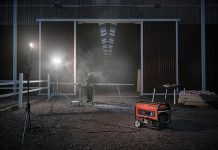Tony and Lynn Phillip’s 5 500ha farm Bucklands, near Grahamstown, is dominated by Valley Bushveld, characterised by shrubs, succulents and sweet grass – when intact. Similar to the Spekboomveld of the drier mountains and plains, and to the Noorsveld of the central Sundays River region, Valley Bushveld is influenced by the unique microclimates of river valleys in the Eastern Cape and southern KZN. A t this time of the year, classic Valley Bushveld is characterised by splashes of purple flowers, blooming on the ubiquitous succulent shrub, spekboom (Portulacaria afra), a key browsing plant on Bucklands. “Spekboom is important here and should be used as sustainably as possible,” explains Tony. It enjoys priority status on Bucklands, thanks not only to its ecological role as a dominant species, but its productive clout in Tony’s successful Angora goat enterprise.
The destruction of succulent thicket Managing the fine balance between Angora goat farming and conservation can be demanding. Goats have decimated spekboom and associated succulent thicket vegetation across much of the Eastern Cape. Up to 80 000ha of thicket has been transformed from thick, two-phase perennial vegetation into a structurally simple landscape, dominated by ephemeral grasses, forbs and isolated canopy trees. Only recently have farmers, conservationists, academics and government acknowledged this trend as a major problem. Research shows that intact succulent thicket offers far greater browsing and grazing potential than it does after this transformation. Spekboom and farmers Research also shows that spekboom land is fertile land. Spekboom plays a vital role in the succulent thicket, regulating the soil’s organic matter by creating specific microclimates, and by litter distribution, erosion control and the related improvement of water infiltration and retention. Unsurprisingly, there are stark differences between carbon content in intact thicket soils and the soils of transformed, degraded thicket. Transformed thicket areas can exhibit up to 35% less soil carbon, to a depth of 10cm, and 75% less biomass.
Research also indicates thicket vegetation, particularly spekboom, is difficult to re-establish without actual planting. To attempt such planting, the Department of Water Affairs and Forestry launched the Baviaanskloof Subtropical Thicket Restoration Pilot Project. The project investigates the success of aided vegetative spekboom reproduction in the Baviaanskloof Megareserve. Tony’s veld management system is based on spekboom’s protection and sustainable use, not only for ecological reasons, but also to ensure sustainable production. “Research has shown that if you defoliate spekboom by 50% it could take up to seven months to recover completely,” he explains. Continual utilisation of spekboom is a death sentence for both the browsing and sweet-grazing potential of Valley Bushveld. Sustainable browsing and grazing Valley Bushveld should be browsed in a way that benefits the spekboom as well as the grass cover, says Tony. He uses a specific combination of browsers and grazers to perform various functions (see box: The role played by grazers and browsers). At the core of Tony’s veld management system is the concept of high-density grazing in camps averaging 25ha, laid out in a wagon wheel pattern.
“First, cattle graze for one to two weeks, followed by intense high-density browsing by goats for two to three weeks,” Tony explains. “Dorpers, which are both grazers and browsers, are managed according to climatic conditions.” After about a month of intense grazing and browsing the camp is rested for 11 months. “The key is a long rest period, which allows the spekboom enough recovery,” Tony says. Such long rests also ensure the grass gets moisture in an unreliable summer rainfall area. “Chances are you’ll pick up some rain either in autumn or spring, improving the bush’s palatability. By looking after your bush, you look after your grass,” explains Tony. Flocks and herds are managed according to climatic conditions that can be punishing, with an average annual rainfall of 350mm to 450mm. FW








